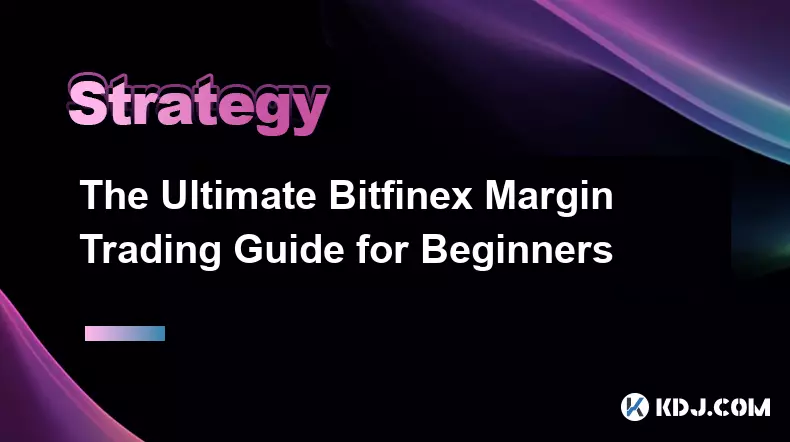-
 bitcoin
bitcoin $95122.959084 USD
-0.06% -
 ethereum
ethereum $3142.532402 USD
-0.28% -
 tether
tether $0.999439 USD
0.01% -
 xrp
xrp $2.209207 USD
-2.80% -
 bnb
bnb $925.395975 USD
0.07% -
 solana
solana $138.662599 USD
-1.73% -
 usd-coin
usd-coin $0.999753 USD
-0.02% -
 tron
tron $0.294100 USD
0.03% -
 dogecoin
dogecoin $0.161321 USD
0.35% -
 cardano
cardano $0.498672 USD
-1.53% -
 hyperliquid
hyperliquid $38.406659 USD
1.34% -
 zcash
zcash $679.663571 USD
5.44% -
 bitcoin-cash
bitcoin-cash $501.381807 USD
3.53% -
 chainlink
chainlink $13.975571 USD
-0.64% -
 unus-sed-leo
unus-sed-leo $9.166130 USD
-0.37%
The Ultimate Bitfinex Margin Trading Guide for Beginners
Bitfinex offers margin trading with up to 5x leverage, allowing traders to amplify gains—or losses—by borrowing funds, with risks managed through liquidation monitoring and cross-margin collateral.
Aug 30, 2025 at 11:36 pm

The Basics of Bitfinex Margin Trading
1. Bitfinex is one of the oldest and most established cryptocurrency exchanges offering advanced trading tools, including margin trading. This feature allows traders to borrow funds to increase their trading position beyond what their own capital would allow. By using leverage, traders can potentially amplify their profits, though it also increases the risk of larger losses.
2. To begin margin trading on Bitfinex, users must first transfer funds into their margin wallet. This is separate from the exchange and funding wallets. Once funds are in the margin wallet, they serve as collateral for borrowed assets. The platform supports margin trading for a variety of cryptocurrency pairs, including BTC/USD, ETH/USD, and others.
3. Bitfinex offers different levels of leverage, typically ranging from 2x to 5x, depending on the asset and market conditions. Higher leverage increases both potential gains and risks. Traders must carefully assess their risk tolerance and understand how margin calls and liquidations work before entering positions.
4. The platform uses a dynamic margin system where the required collateral adjusts based on market volatility and position size. If the value of a trader’s position falls below the maintenance margin level, Bitfinex may issue a margin call or automatically liquidate the position to cover the debt.
5. Traders should familiarize themselves with the interface, including the order book, position tracker, and lending markets. Understanding how to read liquidation prices and funding rates is essential for managing risk effectively.
How to Set Up a Margin Position on Bitfinex
1. After logging into your Bitfinex account, navigate to the trading interface and select the desired trading pair. Ensure your funds are in the margin wallet by transferring from your exchange or deposit wallet if necessary.
2. Choose the “Margin” trading mode instead of the default spot mode. This activates the margin trading features and allows access to leverage options. The available leverage will be displayed based on your account tier and the selected pair.
3. Place a limit or market order as you would in spot trading. However, in margin mode, the system will calculate the required margin and display the liquidation price. Review these values carefully before confirming the trade.
4. Once the order is filled, the position appears in the “Active Positions” section. Here, you can monitor unrealized P&L, leverage used, and estimated liquidation price. You can also add or reduce margin manually to adjust risk exposure.
5. To close the position, place an opposing order of equal or greater size. The system will automatically settle the borrowed funds and return any remaining collateral to your margin wallet, minus fees and funding costs.
Managing Risk in Bitfinex Margin Trading
1. Always set stop-loss orders to limit potential losses. Even with careful analysis, market volatility can trigger rapid price movements. A stop-loss helps protect your capital by closing the position at a predetermined price.
2. Monitor funding rates and interest costs closely. Bitfinex charges funding fees for borrowed assets, which are paid every 4 hours. High funding rates can erode profits over time, especially in long-term positions.
3. Avoid over-leveraging. While 5x leverage may seem attractive, it significantly reduces the buffer against price swings. Using lower leverage provides more room for error and reduces the likelihood of liquidation.
4. Diversify your trading strategy. Relying solely on margin trades increases exposure to systemic risks. Combining margin positions with spot holdings and hedging strategies can improve overall portfolio resilience.
5. Stay informed about market news and macroeconomic factors. Cryptocurrency prices are highly sensitive to regulatory announcements, technological developments, and global financial trends. Being aware of these can help anticipate sharp movements that impact margin positions.
Frequently Asked Questions
What is the difference between isolated and cross margin on Bitfinex?Bitfinex primarily uses a cross-margin system, where all funds in the margin wallet are pooled and used as collateral for open positions. This differs from isolated margin, where each position has a dedicated collateral amount. Cross margin can offer more flexibility but also increases the risk of total account liquidation if losses are severe.
How does Bitfinex determine liquidation prices?The liquidation price is calculated based on the position size, leverage used, current market price, and maintenance margin requirements. Bitfinex continuously monitors these variables and closes positions when the equity in the margin wallet falls below the required threshold. The exact formula is displayed in the trading interface for transparency.
Can I lend my crypto on Bitfinex to earn funding interest?Yes, Bitfinex allows users to act as lenders by placing funding offers in the lending book. When traders open margin positions, they borrow from these offers and pay interest every 4 hours. Lenders can set their own rates and amounts, though funding may not be fully utilized during periods of low demand.
Are there fees for opening or closing margin positions?Bitfinex does not charge additional fees specifically for opening or closing margin trades beyond the standard trading fees. However, funding rates (interest on borrowed funds) are applied periodically and can vary based on supply and demand in the lending market. These costs are separate from trading fees and should be factored into the overall strategy.
Disclaimer:info@kdj.com
The information provided is not trading advice. kdj.com does not assume any responsibility for any investments made based on the information provided in this article. Cryptocurrencies are highly volatile and it is highly recommended that you invest with caution after thorough research!
If you believe that the content used on this website infringes your copyright, please contact us immediately (info@kdj.com) and we will delete it promptly.
- Coinbase's Big Moves: Primed for Crypto Domination in 2025?
- 2025-11-16 20:10:01
- Bitcoin ETFs, Liquidity Crisis, and Market Bleeding: A New York Minute
- 2025-11-16 20:10:01
- Bitcoin, Robert Kiyosaki, and the Crash Watch: A New Yorker's Take
- 2025-11-16 20:05:01
- SUI, Crypto Presales, and Price Predictions: What's the Hype?
- 2025-11-16 20:05:01
- Tether's AI Gambit: Investing in Neura Robotics and the Future of Investment
- 2025-11-16 20:00:01
- Pi Network Price Rebound: Whale Buy Signals Growing Confidence?
- 2025-11-16 19:55:01
Related knowledge

The Beginner's Guide to Decentralized Exchanges (DEX): Trading with Control.
Nov 16,2025 at 05:20pm
The Beginner's Guide to Decentralized Exchanges (DEX): Trading with Control Decentralized exchanges, commonly known as DEXs, are transforming the way ...

Lump-Sum vs. DCA in Crypto: A Guide to Choosing the Right Strategy.
Nov 16,2025 at 06:40am
Lump-Sum Investing in Cryptocurrencies1. Lump-sum investing involves allocating a large amount of capital into cryptocurrency assets all at once. This...

How to Trade Crypto Breakouts: A Strategy for Capturing Big Moves.
Nov 16,2025 at 03:59pm
Understanding Crypto Breakouts1. A breakout in the cryptocurrency market occurs when the price of an asset moves beyond a defined support or resistanc...

The Complete Guide to Liquidity Mining: Earning Rewards in DeFi.
Nov 14,2025 at 12:40am
Understanding Decentralized Exchanges in the Crypto Ecosystem1. Decentralized exchanges (DEXs) operate without a central authority, allowing users to ...

How to Research a Crypto Project: A Guide to Avoiding Rug Pulls.
Nov 14,2025 at 09:20pm
Understanding Decentralized Exchanges in the Crypto Ecosystem1. Decentralized exchanges (DEXs) have emerged as a pivotal component of the cryptocurren...

A Beginner's Guide to Crypto Wallets: How to Secure Your Digital Assets.
Nov 14,2025 at 11:39am
Understanding the Basics of Crypto Wallets1. A crypto wallet is not a physical container but a digital tool that stores private and public keys, allow...

The Beginner's Guide to Decentralized Exchanges (DEX): Trading with Control.
Nov 16,2025 at 05:20pm
The Beginner's Guide to Decentralized Exchanges (DEX): Trading with Control Decentralized exchanges, commonly known as DEXs, are transforming the way ...

Lump-Sum vs. DCA in Crypto: A Guide to Choosing the Right Strategy.
Nov 16,2025 at 06:40am
Lump-Sum Investing in Cryptocurrencies1. Lump-sum investing involves allocating a large amount of capital into cryptocurrency assets all at once. This...

How to Trade Crypto Breakouts: A Strategy for Capturing Big Moves.
Nov 16,2025 at 03:59pm
Understanding Crypto Breakouts1. A breakout in the cryptocurrency market occurs when the price of an asset moves beyond a defined support or resistanc...

The Complete Guide to Liquidity Mining: Earning Rewards in DeFi.
Nov 14,2025 at 12:40am
Understanding Decentralized Exchanges in the Crypto Ecosystem1. Decentralized exchanges (DEXs) operate without a central authority, allowing users to ...

How to Research a Crypto Project: A Guide to Avoiding Rug Pulls.
Nov 14,2025 at 09:20pm
Understanding Decentralized Exchanges in the Crypto Ecosystem1. Decentralized exchanges (DEXs) have emerged as a pivotal component of the cryptocurren...

A Beginner's Guide to Crypto Wallets: How to Secure Your Digital Assets.
Nov 14,2025 at 11:39am
Understanding the Basics of Crypto Wallets1. A crypto wallet is not a physical container but a digital tool that stores private and public keys, allow...
See all articles

























![Coin Master Hack Spins 2025 ✅ Coin Master Free Spins[ Android _ iOS ] [LINK IN COMMENT] Coin Master Hack Spins 2025 ✅ Coin Master Free Spins[ Android _ iOS ] [LINK IN COMMENT]](/uploads/2025/11/16/cryptocurrencies-news/videos/6919c627821e7_image_120_90.webp)
















































